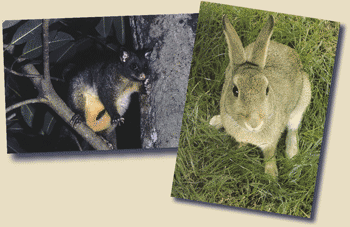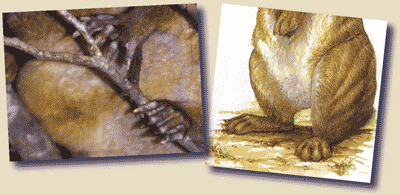|
||||||||||
|
||||||||||
| Questions/instructions:
|
||||||||||
| |
%
responses |
|||||||||
| 1.
Kei hea te käinga o te paihamu? Körero mai mö töna
käinga. Tell me about where the possum lives. Where does it make its home? |
bush/forest/trees
|
100 |
||||||||
| 2.
Kei hea te käinga o te räpeti? Körero mai mö töna
käinga. Tell me about where the rabbit lives. Where does it make its home? |
Usual
habitat:
|
|||||||||
| fields/hills/grass/paddocks
|
56 |
|||||||||
| underground
in holes/burrows/warrens
|
83 |
|||||||||
|
Hoatu te pikitia tuatahi ki te äkonga:
Te Paihamu. Give student picture 1: possum. |
||||||||||
3.
Äta
tirohia te pikitia o te paihamu. He aha öna tino ähuatanga
e ora ai ia i töna taiao? Let’s look
at the possum. What is special about this animal that helps it survive
and live in its natural surroundings? |
Possible
features:
[claws for climbing/eating; fur for warmth or camouflage; tail for balance; whiskers for sense of space; large eyes to see in dark; sharp teeth for eating] |
|||||||||
| 2
or more relevant features plus good justification
|
21 |
|||||||||
| 1
relevant feature plus good justification
|
17 |
|||||||||
| 2
or more relevant features but no justification
|
20 |
|||||||||
| 1
feature, not justified
|
23 |
|||||||||
|
Hoatu te pikitia tuarua ki te äkonga:
Te Räpeti. Give student picture 2: rabbit. |
||||||||||
4.
Äta tirohia te pikitia o te räpeti. He aha öna tino ähuatanga
e ora ai ia i töna taiao? Let’s look
at the rabbit. |
Possible
features:
[large feet and claws for digging burrows; large back legs for running fast; large ears to hear danger easily, fur for warmth and camouflage; large eyes to see in dark; big sharp front teeth for cutting/eating grass and leaves] |
|||||||||
| 2
or more relevant features plus good justification
|
21 |
|||||||||
| 1
relevant feature plus good justification
|
31 |
|||||||||
| 2
or more relevant features but no justification
|
13 |
|||||||||
| 1
feature, not justified
|
21 |
|||||||||
|
||||||||||
| 5.
Äta tirohia ngä waewae o ngä kararehe.Ki töu whakaaro
he aha e rerekë ai te waewae paihamu me te waewae räpeti? This time look carefully at the animals’ feet. Why do you think possum and rabbit feet are different? |
||||||||||
| 6.
He aha ngä tino ähuatanga o te waewae paihamu e ora ai ia i
töna taiao? What is special about a possum’s feet that helps it live and survive? |
||||||||||
| 7.
He aha ngä tino ähuatanga o te waewae räpeti e ora ai ia
i töna taiao? What is special about a rabbit’s feet that helps it live and survive? |
||||||||||
| Based on all three questions: | ||||||||||
| explains
that feet have different functions
(e.g. climbing for possum, digging for rabbit) |
75 |
|||||||||
| Possums’
feet: [sharp claws for feeding, climbing, defense] |
mentions
claws and 2–3 functions
|
20 |
||||||||
| mentions
claws and 1 function
|
44 |
|||||||||
| mentions
claws but no function
|
22 |
|||||||||
| Rabbits’
feet: [large back legs for fast travel, defense and burrowing; front feet for holding food, defense and burrowing] |
1
or more features with good explanation
|
34 |
||||||||
| 1
or more features without useful explanation
|
42 |
|||||||||
Total
Score: |
17–20
|
10 |
||||||||
| 13–16
|
24 |
|||||||||
| 9–12
|
46 |
|||||||||
| 5–8
|
18 |
|||||||||
| 0–4
|
2 |
|||||||||
| Commentary: Most students had basic knowledge about possums and rabbits but less than half could explain how the animals' features demonstrated adaptation to their lifestyle and environment. |
||||||||||
| |
||

